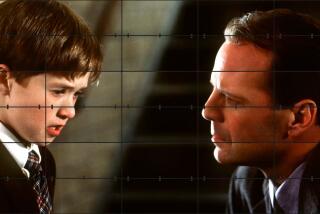Going soft on Shyamalan
LONG before Michael Bamberger wrote âThe Man Who Heard Voices,â a chronicle of filmmaker M. Night Shyamalanâs making of âLady in the Waterâ (which opens in theaters today), the author described caddying for a quirky professional golfer in Europe. The temptation now is to say that heâs carrying water, if not golf clubs, for the director, whom he lionizes at times.
But although Bamberger lauds Shyamalan early and often for his âamazingly energeticâ charm with such lines as, âI felt a powerful force coming off the guy,â he also closely scrutinizes the director and his neurotic, self-obsessed quest to make cinema art. We meet a Shyamalan under pressure -- his box office and reviews have weakened since his 1999 hit âThe Sixth Sense,â which grossed $673 million worldwide. And we donât much like him as he accuses his crew of screw-ups. One such outburst was triggered by the directorâs nervousness over his own, little-admired acting in the film: âYou have failed,â Bamberger quotes him telling a crew member. And howâs this for damning with faint praise: âIn my experience, watching elite athletes and others with off-the-chart drive, thereâs a certain obvious ruthlessness.... Nightâs was beneath the surface.â
It would be easy to presume, from published excerpts of this book in The Times and elsewhere, that former Disney exec Nina Jacobson is the whipping girl in this story. But Jacobson (who was fired this week in an apparently unrelated corporate restructuring) is eventually exonerated for having -- accurately, it would appear -- vivisected Shyamalanâs âLadyâ screenplay over a dinner in Philadelphia: âIn a way, what she did was brave,â Bamberger writes. âThe easy thing would have been to say yes to a director who always made you money.â Even Shyamalan seems to feel he has shortchanged his vision. After a private screening, he asks Bamberger, âWhere did it lose you?â
Bamberger twits Bryce Dallas Howard, who plays the filmâs title character, for her health food obsessions and general neediness. (âNight felt she was turning into ... an actress.â) But leading man Paul Giamatti, who frequently is portrayed making a well-timed quip as Shyamalan kvetches, is intriguingly analyzed through the prism of his dad, Bart, the late baseball commissioner. Bamberger also reveals how often Shyamalan thinks about Bob Dylan and Michael Jordan as artistic touchstones.
A senior writer for Sports Illustrated, Bamberger has a casual, discursive style -- âBefore I get to Night, let me tell you about his wife, Bhavna.â And yet, as the bookâs title seems to suggest, he has an eagerness to inject deeper psychological meaning into the story of a sometimes lovable, but by any measure cosseted, media star. (Being told that Tiger Woods, like Shyamalan, made an American Express ad hardly makes us thrill to the directorâs keen sense of artistic integrity.)
The âVoicesâ of the title refers in part to the people who watch various test screenings: âHe could tell [his filmsâ impact] from their silences and their gasps and their rustling.â But alas, Bamberger tells us, âThe Disney people had gotten deep inside his head, interfering with the good work the voices were supposed to do -- and it would be hell to get them out.â Thereâs something smarmy about the authorâs seeming access to his solipsistic subjectâs brain. When he channels Shyamalan on Jacobsonâs evaluation of his work (âNina had no idea what Night was talking about. Night could tell.â), one is tempted to say, âOh, shut up!â
Finally, thereâs the question of all that access. The book opens with a preface titled âApril 17, 2004,â an account of the author and subjectâs instant bonding at a dinner party of Philadelphia power players that leads Shyamalan to agree to be profiled like the characters in Bambergerâs well-reviewed 2005 book âWonderland: A Year in the Life of an American High School.â
Bamberger once caused a stir while covering golfer Michelle Wieâs pro debut for Sports Illustrated (as he painfully recalls near the end of this book) by telling PGA officials that heâd seen Wie improve her ballâs position. (He âratted her out,â according to the Washington Post.) Golf has strict rules; so does biography. Yet Bamberger makes a declaration early in this book, only to move the ball on us later. âYou realize that nobody from the high school had any say about what went in the book, donât you?â he tells his subject early on.
Well, fine, you say, letâs put our feet up and read this no-holds-barred account. Problem is, on the bookâs final page, he writes, âNight read the book in manuscript form and made numerous suggestions, many of which I took him up on.... He made no suggestions to make himself look better, which is part of his dazzling oddness.â Dazzling indeed. Bamberger has talent, reporting chops and clear dedication that shows in many detailed passages. But more than a few people, after reading that rationalization, may want to tell him to shut up.
Fred Schruers is a senior editor for Premiere magazine.
*
The Man Who Heard Voices
Or, How M. Night Shyamalan Risked His Career on a Fairy Tale
Michael Bamberger
Gotham Books: 280 pp., $27.50
More to Read
Only good movies
Get the Indie Focus newsletter, Mark Olsen's weekly guide to the world of cinema.
You may occasionally receive promotional content from the Los Angeles Times.










